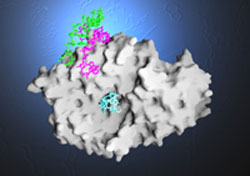Yale scientists identify structure for RNA quality control

Illustration of Ro with RNAs (pink & green) in surface binding sites and misfolded RNA (aqua) in the ’hole’
A report by Yale scientists in the journal Cell sheds new light on how the protein Ro, a major autoantigen in patients with autoimmune disease, recognizes misfolded RNAs, creating a RNA quality control system for cells.
The quality control process in the cell has been well-studied for the DNA and messenger RNA (mRNA) components for making proteins. However, little was known about what cells do with abnormal or misfolded RNAs that are not translated into protein — such as ribosomal RNAs (rRNAs), transfer RNAs (tRNAs), and small nuclear and cytoplasmic regulatory RNAs. This work describes a molecular mechanism of RNA quality control.
In the autoimmune disorders systemic lupus erythematosus and Sjogren’s syndrome, Ro is known to be an autoantigen, and autoimmune disease develops in mice that lack Ro protein. This study demonstrated a connection between binding of normal RNA and “disposal” of abnormal and misfolded RNAs by Ro protein.
Collaboration between the laboratories of Assistant Professor Karin M. Reinisch and Associate Professor Sandra L. Wolin in the department of Cell Biology used both crystallography and biochemistry to visualize how Ro interacts with these RNAs.
“The crystal structures of Ro revealed two distinct RNA binding sites, one of which recognizes misfolded small RNAs. Unlike most proteins, Ro has a hole through the middle – and the hole is used in distinguishing these RNAs,” said Reinisch.
Mothers with anti-Ro antibodies often have babies with heart signal conduction defects; some scientists believe that the antibodies may cause the defects. “Although Ro is a major human autoantigen, how the molecule is recognized by patient autoantibodies was not fully determined. So, understanding these features of the Ro protein may allow the design of drugs to block the interaction between the antibodies and Ro,” said Wolin.
The research team consisted of members from the Reinisch and Wolin lab groups– Adam J. Stein, Gabriele Fuchs, Chumei Fu. Wolin is also an investigator of the Howard Hughes Medical Institute. The work was funded by grants from the G. Harold and Leila Y. Mathers Foundation, the Pew Charitable Trust, and the National Institutes of Health.
Media Contact
All latest news from the category: Life Sciences and Chemistry
Articles and reports from the Life Sciences and chemistry area deal with applied and basic research into modern biology, chemistry and human medicine.
Valuable information can be found on a range of life sciences fields including bacteriology, biochemistry, bionics, bioinformatics, biophysics, biotechnology, genetics, geobotany, human biology, marine biology, microbiology, molecular biology, cellular biology, zoology, bioinorganic chemistry, microchemistry and environmental chemistry.
Newest articles

Microscopic basis of a new form of quantum magnetism
Not all magnets are the same. When we think of magnetism, we often think of magnets that stick to a refrigerator’s door. For these types of magnets, the electronic interactions…

An epigenome editing toolkit to dissect the mechanisms of gene regulation
A study from the Hackett group at EMBL Rome led to the development of a powerful epigenetic editing technology, which unlocks the ability to precisely program chromatin modifications. Understanding how…

NASA selects UF mission to better track the Earth’s water and ice
NASA has selected a team of University of Florida aerospace engineers to pursue a groundbreaking $12 million mission aimed at improving the way we track changes in Earth’s structures, such…





















